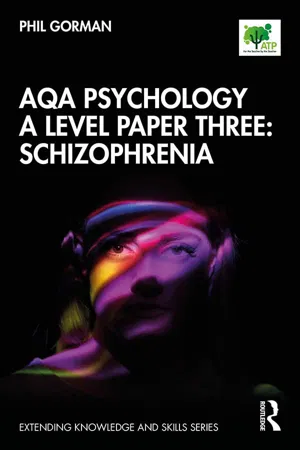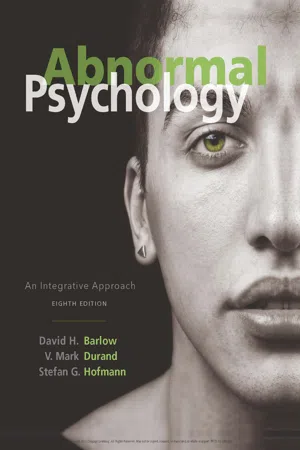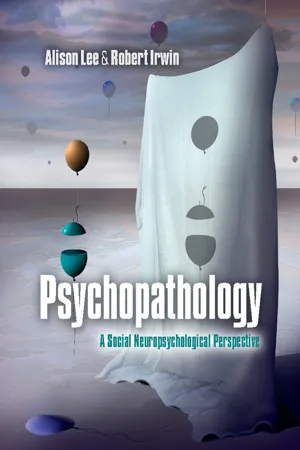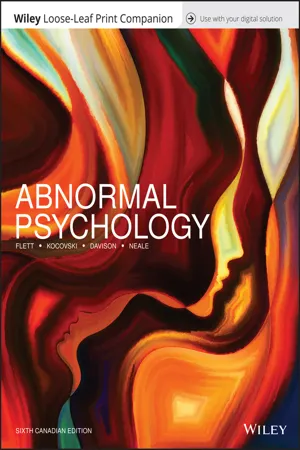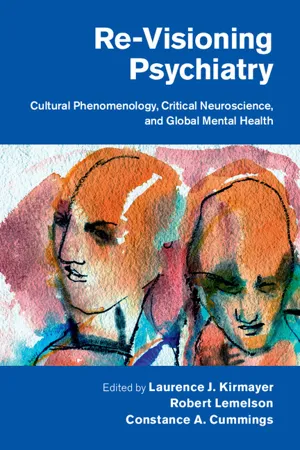Psychology
Theories of Schizophrenia
Theories of schizophrenia propose various explanations for the development and manifestation of this mental disorder. Biological theories emphasize genetic and neurobiological factors, while psychological theories focus on the role of early experiences and cognitive processes. Sociocultural theories consider the influence of social and cultural factors on the onset and course of schizophrenia. These theories contribute to our understanding of the complex nature of schizophrenia.
Written by Perlego with AI-assistance
Related key terms
1 of 5
9 Key excerpts on "Theories of Schizophrenia"
- Phil Gorman(Author)
- 2020(Publication Date)
- Routledge(Publisher)
Chapter 4Spec checkPsychological explanations for schizophrenia
Psychological explanations for schizophrenia: family dysfunction and cognitive explanations, including dysfunctional thought processing.AO1 (Knowledge and understanding): What are the psychological explanations for schizophrenia?
Psychological influences on mental health
In Chapter 3 , the World Health Organisation (WHO) definition for mental disorders suggested a clear role for the mind and behaviour, rather than for biological factors. These psychological factors include a variety of influences, ranging from specific environmental factors that have a social influence on us and alter our behaviour to factors that are directly related to mental processes and affect our understanding of the world around us. All these factors can affect our normal daily lives through their influence on our thoughts and feelings, which may sometimes beadaptivebut at times can bemaladaptivetoo.Psychological influences focus on the factors that have caused a person’s mind and behaviour to develop in the way that it has, rather than the biological influences on their brain and nervous system looked at in Chapter 3 . These psychological influences are likely to be those that relate to a person’s upbringing and their treatment by those around them, e.g. by their parents. In the past, psychologists have gone as far as to blame the mother for the way that she has brought up her children, specifically with the notion of theschizophrenogenic mother- eBook - PDF
Abnormal Psychology
An Integrative Approach
- David Barlow, V. Durand, Stefan Hofmann, , David Barlow, V. Durand, Stefan Hofmann(Authors)
- 2017(Publication Date)
- Cengage Learning EMEA(Publisher)
Biological Psychiatry, 50, p. 885.) Copyright 2018 Cengage Learning. All Rights Reserved. May not be copied, scanned, or duplicated, in whole or in part. WCN 02-200-208 PREVALENCE AND CAUSES OF SCHIZOPHRENIA 499 be partially the result of misdi-agnosis rather than the result of any real cultural distinctions. An additional factor contribut-ing to this imbalance may be the levels of stress associated with factors such as stigma, isolation, and discrimination (Anglin, Lighty, Greenspoon, & Ellman, 2014; Pinto, Ashworth, & Jones, 2008). Genetic Influences We could argue that few areas of abnormal psychology so clearly illustrate the enormous com-plexity and intriguing mystery of genetic influences on behav-ior as does the phenomenon of schizophrenia (Murray & Castle, 2012). Despite the possibil-ity that schizophrenia may be several different disorders, we can safely make one generalization: Genes are responsible for making some individuals vulnerable to schizophrenia. We look at a range of research findings from family, twin, adoptee, offspring of twins, and linkage and association studies. We conclude by discussing the compelling reasons that no one gene is responsible for schizophre-nia; rather, multiple gene variances combine to produce vulnerabil-ity (Murray & Castle, 2012). Family Studies In 1938, Franz Kallmann published a major study of the fami-lies of people with schizophrenia (Kallmann, 1938). Kallmann examined family members of more than 1,000 people diagnosed with schizophrenia in a Berlin psychiatric hospital. Several of his observations continue to guide research on schizophrenia. Kallmann showed that the severity of the parent’s disorder influ-enced the likelihood of the child’s having schizophrenia: The more severe the parent’s schizophrenia, the more likely the children were to develop it. Another observation was important: All forms of schizophrenia (for example, the historic categories such as cata-tonic and paranoid) were seen within the families. - eBook - PDF
- W.J. Baker, M.E. Hyland, H. van Rappard, A.W. Staats(Authors)
- 1986(Publication Date)
- North Holland(Publisher)
Current Issues in Theoretical Psychology Wm J. Baker, M.E. Hyland, H. Van Rappard, A.W. Staats (Editors) 0 Elsevier Science Publishers B.V. (North-Holland), 1987 SYSTEMS, CAUSALITY, AND TIME: A FRAMEWORK FOR THE INTEGRATION OF Theories of Schizophrenia John Gosling Hatfield Polytechnic Hatfield, England SUMMARY: This paper deals with the integration of theories expressed in different theoretical languages. Brief details of a conceptual schema for the classification of theories with different explanatory functions are presented and this is then applied to the special case of theories of schiz- ophrenia Certain abstract properties of theoretical languages are dis- cussed and tne paper concludes with a consideration of differences in the temporal characteristics of theoretical languages. 85 In recent years, a number of distinct hypotheses have emerged with regard to the causation of schizophrenia. Firstly. several studies have provided convincing evidence that there exists a hereditary basis for the disorder (Heston & Denny, 1968; Kety , Rosenthal, Wender , & Schulsing- er, 1968). Secondly, research in neurochemistry and pharmacology has pointed to the role of the neurotransmitter dopamine. The current hypo- thesis is that the clinical state of schizophrenia is associated with raised levels of activity in the dopaminergic regions of the brain (Iverson, 1978). Thirdly, there is evidence that in roughly half the cases of new admissions for schizophrenia, the onset of the illness is preceded by a major change in the life circumstances of the patient (a life event) occurring within the three weeks prior to admission (Birley & Brown, 1970; Leff & Vaughn, 1980). Finally, a growing number of studies have shown that the emo- tional characteristics of the patient's immediate family are very strongly related to relapse after an earlier episode of the disorder. - David Sue, Derald Wing Sue, Diane Sue, Stanley Sue(Authors)
- 2016(Publication Date)
- Cengage Learning EMEA(Publisher)
The different models included biological (e.g., physical illness or substance abuse), social (e.g., interpersonal problems, stress, negative child-hood events, personality), supernatural (e.g., evil forces, evil magic), and various nonspecific explanations. Anglos from the United Kingdom were the most likely to attribute the condition to biological causes and least likely to identify supernatural causes— the explanation selected by a substantial minority of individuals from the other ethnic groups—as a potential causal factor. Differing views on etiology also influenced response to taking medication for their symptoms. Those who cited biological causes believed they were receiving the correct treatment (medica-tion), whereas those who supported a supernatural explanation wanted alterna-tive forms of treatment, such as religious activities. Thus, views of etiology can affect our understanding of schizophrenia, including its severity, prognosis, and appropriate treatment. Socioeconomic Status and Schizophrenia Schizophrenia is much more prevalent in poorer neighborhoods. Some believe that the increased stress from living in poverty may be the cause; others believe that individuals with schizophrenia move into poorer neighborhoods because of their decreased ability to function in society. Visions of America/Universal Images Group/Getty Images Countries report significant differ-ences in psychotic symptoms. The prevalence of hallucinations ranged from 0.1 percent in Vietnam to 31.0 percent in Nepal.- eBook - PDF
- V. Durand, David Barlow, Stefan Hofmann, , V. Durand, David Barlow, Stefan Hofmann(Authors)
- 2018(Publication Date)
- Cengage Learning EMEA(Publisher)
One prospective study of schizophrenia among dif- ferent ethnic groups in London found that although the outcomes of schizophrenia appear similar across these groups, blacks were more likely to be detained against their will, brought to the hospital by police, and given emergency injections (Goater et al., 1999). The differing rates of schiz- ophrenia, therefore, may be partially the result of misdiag- nosis rather than the result of any real cultural distinctions. An additional factor contributing to this imbalance may be the levels of stress associated with factors such as stigma, isolation, and discrimination (Anglin, Lighty, Greenspoon, & Ellman, 2014; Pinto, Ashworth, & Jones, 2008). Genetic Influences We could argue that few areas of abnormal psychology so clearly illustrate the enormous complexity and intrigu- ing mystery of genetic influences on behavior as does the phenomenon of schizophrenia (Murray & Castle, 2012). Despite the possibility that schizophrenia may be several different disorders, we can safely make one generalization: Genes are responsible for making some individuals vulner- able to schizophrenia. We look at a range of research find- ings from family, twin, adoptee, offspring of twins, and linkage and association studies. We conclude by discussing the compelling reasons that no one gene is responsible for schizophrenia; rather, multiple gene variances combine to produce vulnerability (Murray & Castle, 2012). Family Studies In 1938, Franz Kallmann published a major study of the families of people with schizophrenia (Kallmann, 1938). Kallmann examined family members of more than 1,000 people diagnosed with schizophrenia in a Berlin psychi- atric hospital. He showed that the severity of the parent’s disorder influenced the likelihood of the child’s having schizophrenia: The more severe the parent’s schizophre- nia, the more likely the children were to develop it. - eBook - PDF
Psychopathology
A Social Neuropsychological Perspective
- Alison Lee, Robert Irwin(Authors)
- 2018(Publication Date)
- Cambridge University Press(Publisher)
Over the last couple of decades, this assumption has been challenged by increasingly sophisticated endeavours to under- stand and explain the symptoms of psychosis in psychological terms. However, one regrettable consequence of the continued tendency to ascribe a predominantly organic aetiology to functional psychosis has been the relative neglect of the subjective experience of individuals who are living with psychosis. This chapter starts with a brief outline of some of the possible causal factors for psychosis suggested by people who have first-hand experience of it. We then consider why the vulnerability–stress hypothesis features so prominently in theor- etical conceptualisations of the development of psychosis. Next, we provide an overview of the environmental factors (both social and material) that are associated with the development and recurrence of psychotic experiences. In the final section of this chapter, we examine evidence for a dimensional conceptualisation of psych- otic experience and consider whether the distinction between psychosis and normal experience is as clear-cut as commonly presumed. 8.1 The Views of People who have Psychotic Experiences To date, few studies have sought to investigate how people make sense of their psychotic experiences. One study that has attempted to do this was undertaken by Jim Geekie in New Zealand, and suggests that people who experience psychosis are interested in exploring the possible causes of their psychosis (Geekie, 2004; Geekie and Read, 2009). Participants in Geekie’s research reported a variety of causal factors, which Geekie initially grouped into psychological, social/interpersonal and biological accounts (this was later expanded into a five-category model following an extension of this research by Geekie; see Box 8.1). Among the various biological causes participants suggested were hereditary factors, the brain and drug use. - eBook - PDF
- Gordon L. Flett, Nancy L. Kocovski, Gerald C. Davison, John M. Neale(Authors)
- 2018(Publication Date)
- Wiley(Publisher)
11.3 Etiology of Schizophrenia 325 one who is predisposed—develops schizophrenia. Alternatively, the stressors encountered by those in the lowest social class could be biological; for example, we know that children of mothers whose nutrition during pregnancy was poor are at increased risk for schizophrenia (Susser et al., 1996). Another explanation of the correlation between schizo- phrenia and low social class is the social-selection theory, which reverses the direction of causality between social class and schizophrenia. During the course of their developing psychosis, people with schizophrenia may drift into the pov- erty-ridden areas of the city. The growing cognitive and moti- vational problems besetting these individuals may so impair their earning capabilities that they cannot afford to live else- where. Or, they may choose to move to areas where little social pressure will be brought to bear on them and they can escape intense social relationships. One way of resolving the conflict between these opposing theories is to study the social mobility of people with schizo- phrenia. Consistent with the social-selection theory, some studies (e.g., Turner & Wagonfeld, 1967) found that people with schizophrenia are downwardly mobile in occupational sta- tus. But an equal number of studies have shown that people with schizophrenia are not downwardly mobile (e.g., Dunham, 1965). Clearly, this approach has not resolved the issue. Kohn (1968) suggested another way of examining this question: Are the fathers of people with schizophrenia also from the lowest social class? If they are, this could be considered evidence in favour of the sociogenic hypothesis that lower-class status is conducive to schizophrenia, for class would be shown to precede schizophrenia. If the fathers are from a higher social class, the social-selection hypothesis would be the better explanation. - eBook - PDF
Re-Visioning Psychiatry
Cultural Phenomenology, Critical Neuroscience, and Global Mental Health
- Laurence J. Kirmayer, Robert Lemelson, Constance A. Cummings(Authors)
- 2015(Publication Date)
- Cambridge University Press(Publisher)
Conclusion In this chapter, we have outlined a framework for considering how a range of social factors, acting over time and through stressful life events or daily hassles, could contribute, independently or through ongoing interactions, to the development of psychotic illness. The importance of such models for conceptualizing the social etiology of psychosis lies in demonstrating the complex and multifaceted interplay between individ- ual and ecological dimensions, their interactions, and temporal trajector- ies. The framework also throws into relief the gaps in current knowledge. Our hope is that this framework can directly assist in the design of future research, the planning of interventions aimed at particular risk and protective factors, the training of health and mental health professionals, and the construction and implementation of health and social systems that can more effectively respond to the needs of at-risk populations. Understanding the Social Etiology of Psychosis 335 REFERENCES Allardyce, J., Gilmour, H., Atkinson, J., Rapson, T., Bishop, J., & McCreadie, R. G. (2005). Social fragmentation, deprivation and urbanicity: Relation to first-admission rates for psychoses. British Journal of Psychiatry, 187, 401–6. http://dx.doi.org/10.1192/bjp.187.5.401 Belsky, J., Jonassaint, C., Pluess, M., Stanton, M., Brummett, B., & Williams, R. (2009). Vulnerability genes or plasticity genes? Molecular Psychiatry, 14, 746–54. http://dx.doi.org/10.1038/mp.2009.44 Bentall, R. P., Kinderman, P., & Kaney, S. (1994). The self, attributional processes and abnormal beliefs: Towards a model of persecutory delusions. Behaviour Research Therapy, 32(3), 331–41. http://dx.doi.org/10.1016/0005- 7967(94)90131-7 Bhugra, D., Hilwig, M., Hossein, B., Marceau, H., Neehall, J., Leff, J., . . . Der, G. (1996). First-contact incidence rates of schizophrenia in Trinidad and one-year follow-up. - eBook - PDF
Abnormal Psychology
The Science and Treatment of Psychological Disorders, DSM-5-TR Update
- Ann M. Kring, Sheri L. Johnson(Authors)
- 2022(Publication Date)
- Wiley(Publisher)
Psychological Influences People with schizophrenia do not appear to experience more stress in daily life than people with- out schizophrenia (Phillips, Francey, et al., 2007; Walker et al., 2008). However, people with the disorder appear to be very reactive to the stressors we all encounter in daily living. In one study, people with psychotic disorders (92% with schizophrenia), their first-degree relatives, and peo- ple without any psychiatric disorder participated in a 6-day ecological momentary assessment study in which they recorded stress and mood several times each day. Daily life stress predicted greater decreases in positive moods in both people with schizophrenia and their relatives com- pared with controls. Stress also predicted greater increases in negative moods in the people with schizophrenia compared with both relatives and controls (Myin-Germeys, van Os, et al., 2001). Thus, people with schizophrenia were particularly vulnerable to daily stress. Research also shows that, as with many of the disorders we have discussed in this book, increases in life stress increase the likelihood of a relapse (Walker et al., 2008). Additional research on psychological influences in the development and relapse of schizo- phrenia has focused on sociocultural factors, the family, and developmental factors. Sociocultural Factors: Poverty, Trauma, Urbanicity, and Migration Four sociocultural factors that have been associated with schizophrenia are poverty (socioeconomic status), trauma, urbanicity (living in cities), and migration (moving from one country to another). These three variables can be related to one another, but each appears to be independently associated with a higher risk of developing schizophrenia. For many years, we have known that the highest rates of schizophrenia are found in peo- ple with the highest poverty levels (Hollingshead & Redlich, 1958; Kohn, 1968).
Index pages curate the most relevant extracts from our library of academic textbooks. They’ve been created using an in-house natural language model (NLM), each adding context and meaning to key research topics.
